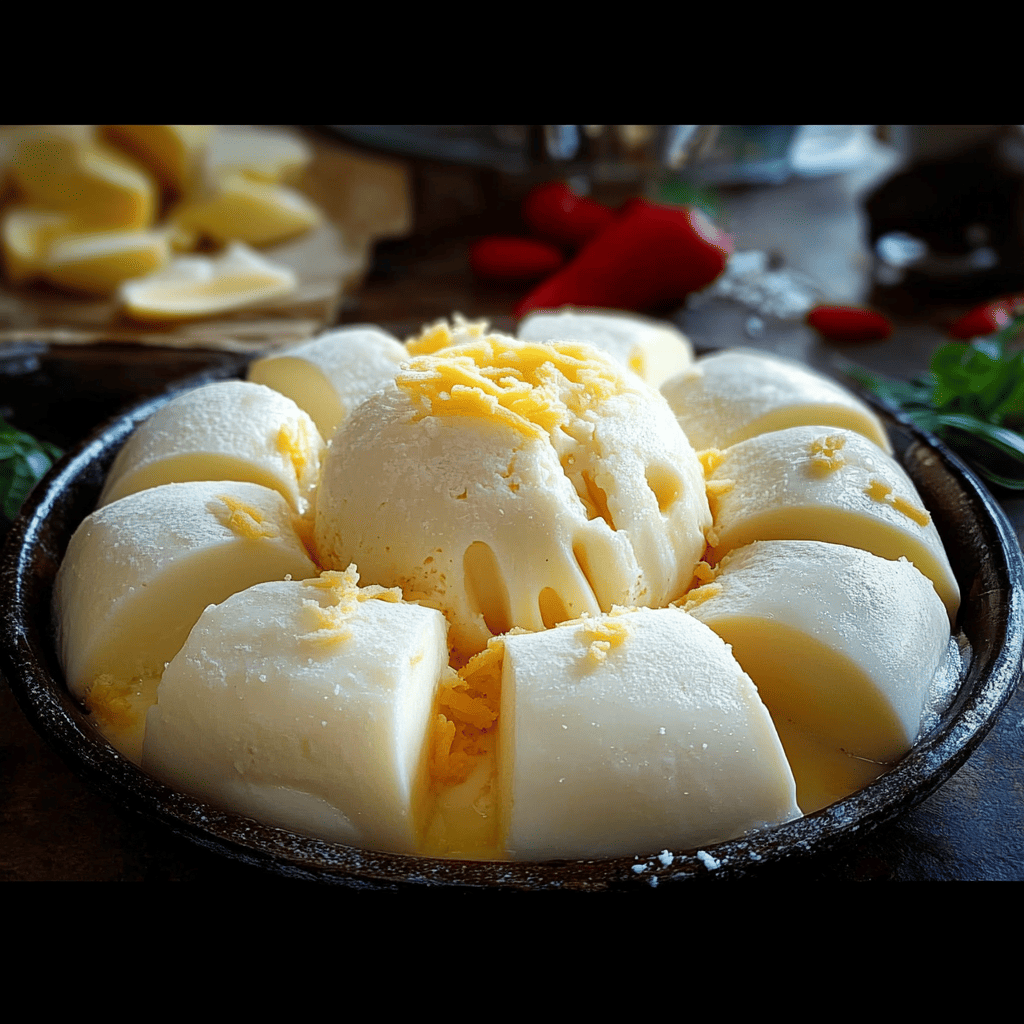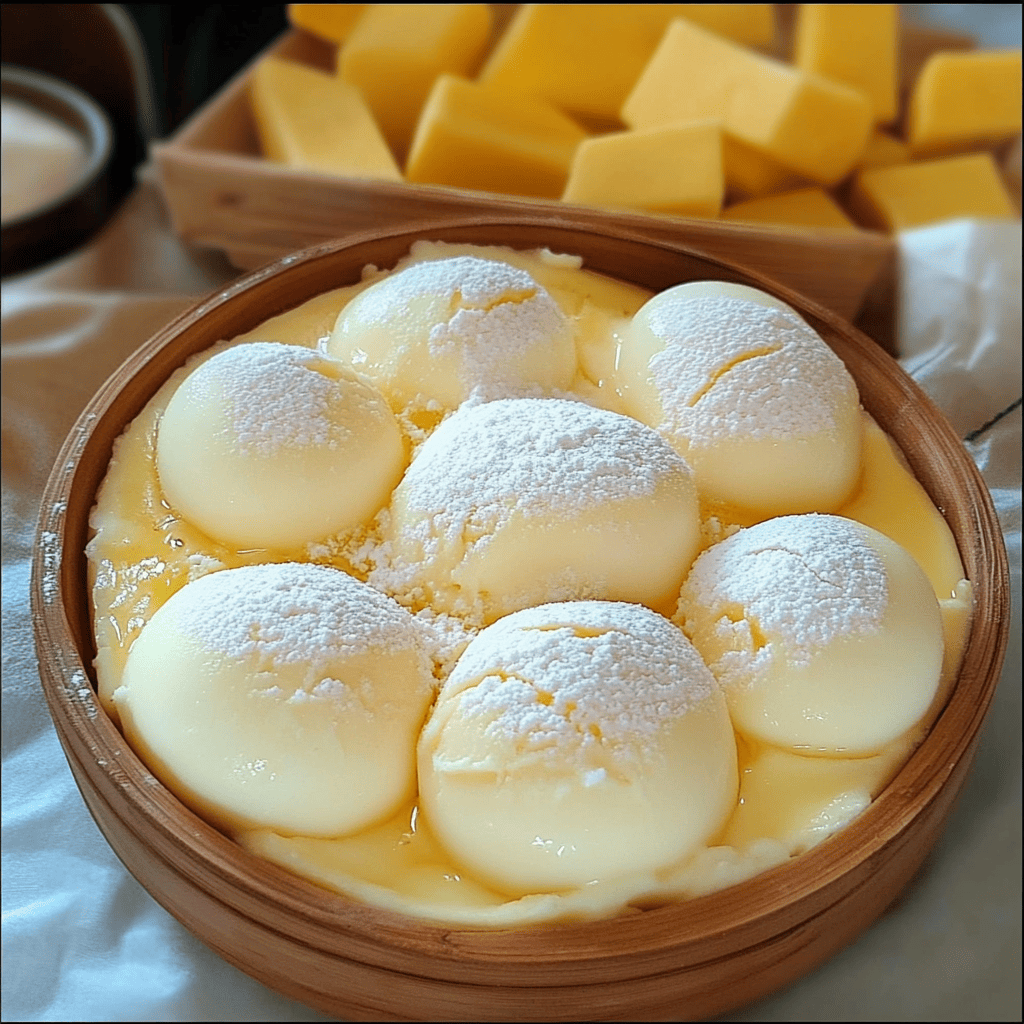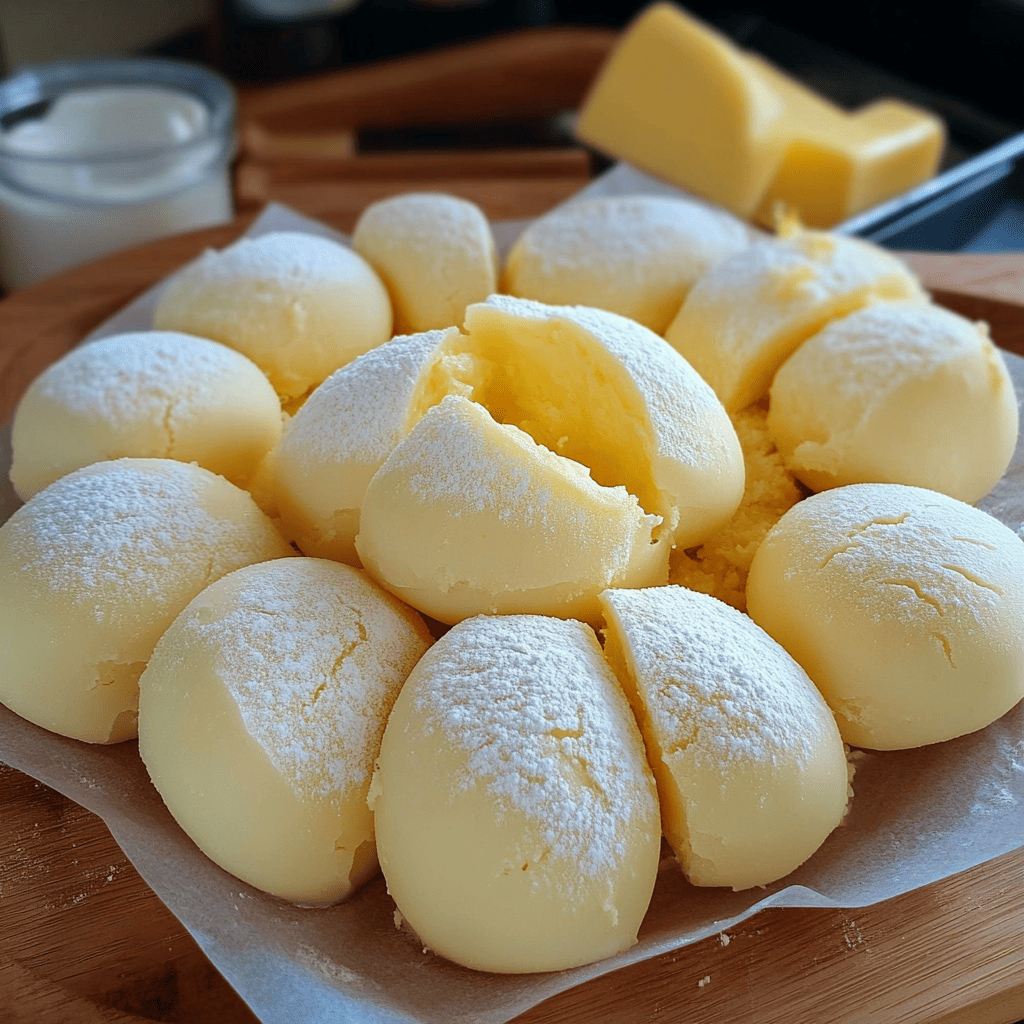Cheese Puto: A Fluffy and Savory Classic of Filipino Cuisine
Introduction: Small Steamed Delights with a Salty Touch
Cheese Puto is an extremely popular Filipino sweet, known for its light, fluffy, steamed texture and distinctive cheesy topping. These small rice cakes are a staple of Filipino breakfasts, snacks, and celebrations, beloved for their simplicity and comforting flavor. The image perfectly captures their neat appearance and the promise of a smooth and delicious experience. Although its name may sound peculiar in Spanish, “Puto” refers to a type of steamed rice cake in the Filipino language, and is a mainstay of Filipino cuisine. Discover all the secrets of this preparation that will delight you with its authenticity and delicious results!
Detailed History in Spanish: A Legacy of Rice and Foreign Influence
The history of Puto is as rich and complex as the history of the Philippines itself, marked by the influence of diverse cultures throughout the centuries. It is a testament to the adaptability and creativity of Filipino cuisine.
Pre-Hispanic Origins and Rice: Rice has been, and continues to be, the staple food in the Philippines since time immemorial. Before the arrival of colonizers, indigenous peoples already used rice not only as a staple grain but also to create various preparations, including cakes and sweets. Puto, in its most basic form, is believed to be one of those ancient creations. Originally, puto was made from fermented rice, giving it a slightly sour taste and a distinctive texture. Fermentation was a common technique for preserving and processing food before refrigeration.
Chinese Influence and Steaming: Steaming is one of the most significant influences of Chinese cuisine in the Philippines. Chinese traders arrived in the islands long before Spanish colonization, bringing with them cooking methods and preparations such as bao (steamed buns). The steaming of puto, a distinctive feature of the dish, most likely stems from this interaction with Chinese cuisine. Many other Filipino dishes, such as siopao (a Filipino version of bao ), also reflect this influence.
The Spanish Colonial Era and the Diversification of Ingredients: During more than three centuries of Spanish colonization, Filipino cuisine absorbed elements of Spanish gastronomy, although in the case of Puto, the influence was more indirect. However, the introduction of new ingredients and the consolidation of trade routes may have facilitated access to ingredients such as sugar and yeast, which, while not essential in the more traditional version of Puto, were incorporated into more modern variations.
Modern Puto and Standardization: Over time, the puto recipe has evolved. While traditional fermented rice puto (known as putong bigas ) still exists and is highly prized for its unique flavor, more modern versions often use rice flour (or even wheat flour for ease of home preparation) and baking powder instead of natural fermentation. This allows for faster preparation and a more consistent, less acidic result.
The Addition of Cheese (“Puto de Queso”): A 20th-Century Innovation: The addition of cheese as a topping is a relatively recent innovation in the history of puto, likely popularized in the mid- to late 20th century. Cheese, especially processed cheese or cheddar cheese, became more accessible and popular in the Philippines due to American influence during and after World War II. The combination of sweet (from the puto) and savory (from the cheese) is a beloved flavor contrast in Filipino cuisine, found in other dishes such as ensaymada (a sweet bread with sugar and cheese). The cheese not only adds flavor, but also a different texture and visual appeal.
Variations and Regional Popularity: Puto is not a monolithic dish; there are countless regional variations in the Philippines, from Puto Bumbong (purple puto cooked in bamboo, popular at Christmas) to Puto Calasiao (a Pangasinan puto with a slightly tangy flavor). Cheese Puto has become one of the most widespread and universally beloved variants, available at street markets, bakeries, and supermarkets across the country. Its portability and versatility in combining with other dishes (such as dinuguan , a meat stew) have cemented its place in the Filipino diet.
In short, “Puto de Queso” is a dish deeply rooted in Filipino rice culture, enriched by Chinese steaming techniques and modernized with the addition of ingredients and flavors that reflect the archipelago’s multicultural history. It’s a small slice of Filipino culinary identity.
More Historical Detail: Simplicity as Art and the Role of the Puto in Society
Delving a little deeper into the history and cultural relevance of the “Puto de Queso,” we can highlight:
- Puto as “Kakanin”: Puto is part of a broader category of Filipino desserts and snacks known as “kakanin,” which are preparations made from rice (or sometimes glutinous rice) and coconut milk, often steamed or baked. Kakanin are central to celebrations, family gatherings, and as offerings. Puto is one of the most accessible and widely consumed kakanin .
- The Importance of Texture: Puto’s soft, fluffy texture is one of its most valued characteristics. This is achieved through the precise combination of ingredients and steaming, which allows the dough to rise without developing a hard crust, unlike baked goods. This softness makes it very palatable, especially for children and the elderly.
- The Name Controversy: The term “Puto” has been the subject of jokes and misunderstandings outside the Philippines due to its connotation in Spanish. However, in Tagalog (the Filipino language), the word has no offensive connotation; it simply describes this type of steamed rice cake. This is a fascinating example of how words can have completely different meanings in different languages and cultures.
- Cheese Puto as “Comfort Food”: For many Filipinos, Cheese Puto is a “comfort food,” a food that evokes nostalgia and memories of childhood and family gatherings. Its simplicity and familiar flavor make it a comforting dish.
- Puto as a Culinary Canvas: While Cheese Puto is one of the most popular variations, the basic Puto is an excellent canvas for experimentation. In addition to cheese, other toppings or flavors can be added to the dough, such as shredded coconut, ube (purple yam), pandan (an aromatic plant), chocolate, or even small sausages, demonstrating its incredible versatility. The “Ube Puto” mentioned in the recipe, with its vibrant purple color, is another popular example of this adaptability.
Puto de Queso’s ability to fuse tradition with innovation, while maintaining its comforting and delicious essence, makes it an emblematic dish of the rich and diverse Filipino cuisine.

Ingredients & Detailed Preparation
Ingredients:
- Cake flour or all-purpose flour: 2 cups (about 250-280 g)
- Sugar: 1 ½ cups (approximately 300 g)
- Baking powder: 2 tablespoons
- Butter (or Dari Creme type margarine), melted: ¼ stick (approximately 28-30 g)
- Evaporated milk: 1 cup (240 ml)
- Eggs: 2 large units
- Water: 1 cup (240 ml)
- Ube Flavoring: 2 teaspoons (for Ube Puto, optional)
- Cheddar cheese (or processed cheese like Eden Cheese), cut into thin strips: for topping
Necessary equipment:
- Large mixing bowls
- Hand or whisk mixer
- Measuring cups and measuring spoons
- Steamer with lid
- Individual molds for Puto (usually small, silicone or metal)
- Clean kitchen towel (to cover the steamer lid)
- Spoon or ladle for pouring the batter
Detailed Preparation:
A. Prepare the Puto Dough:
- Mix dry ingredients: In a large bowl, sift (or whisk together) the cake flour (or all-purpose flour), sugar, and baking powder. Make sure there are no lumps.
- Combine wet ingredients: In a separate bowl, beat the eggs. Then, add the evaporated milk, water, and melted butter. Mix well until all the wet ingredients are combined.
- Blend the mixture: Gradually pour the wet ingredient mixture into the dry ingredients, while whisking continuously with a hand mixer. Beat until the batter is smooth and lump-free. Don’t overmix; just until combined.
- Add flavoring (optional for Ube Puto): If you want to make Ube Puto, add the 2 teaspoons of Ube flavoring to the batter and mix until the color is evenly distributed.
B. Prepare the Molds and Steam:
- Prepare the molds: Lightly grease the individual Puto molds with a little oil or butter. This helps make it easier to remove the Puto from the molds once they’re cooked.
- Fill the molds: Pour the batter into each mold, filling it about 3/4 full. Leave room for the Puto to rise as it steams.
- Prepare the steamer: Fill the bottom of your steamer with water (make sure the water doesn’t touch the top basket). Place the steamer over high heat and bring the water to a boil.
- Adding the cheese: Just before placing the molds in the steamer, place a strip of cheese (or several, depending on the size of the Puto) on the surface of each Puto. The cheese will melt slightly and adhere during cooking.
- Steaming: Once the water is boiling and producing plenty of steam, place the filled molds in the steamer basket. Cover the lid of the steamer with a clean kitchen towel before placing it in the steamer to prevent condensation from dripping on the Puto and making them tender.
- Cooking Time: Steam for 10-15 minutes (time may vary depending on the size of your molds and the power of your steamer). To check for doneness, insert a toothpick into the center of one of the Puto; it should come out clean.
C. Serve:
- Cooling and unmolding: Once cooked, remove the Puto from the steamer. Let them cool slightly in the molds before carefully unmolding them. If using silicone molds, simply push them out from the bottom.
- Serving: Serve Puto de Queso warm or at room temperature. They’re delicious on their own or as a side dish with other Filipino dishes, such as dinuguan .
Estimated Preparation Time
- Active preparation (mixing, filling molds): 15-20 minutes
- Steaming time: 10-15 minutes (per batch, depending on the size of the steamer)
- Total time: Approximately 30-45 minutes (not counting multiple batches if your steamer is small).
Additional Tips
- Do not lift the lid: Avoid lifting the lid of the steamer during cooking, especially in the first 8-10 minutes, as this can cause the Puto to deflate.
- Cloth Cover: The cloth under the lid is crucial to absorb condensed steam and prevent it from dripping onto the Puto, which could make them watery and not as fluffy.
- Cake flour vs. all-purpose flour: Cake flour is finer and has less protein, which will result in an even more tender and soft Puto. If you use all-purpose flour, the result will be equally good, just a little denser.
- Cheese variations: While cheddar or processed cheese is traditional, you can experiment with other cheeses that melt well and offer a salty contrast, such as Edam cheese (which is also popular in the Philippines for other sweet dishes).
- Flavorings: In addition to Ube, you can add pandan extract, vanilla extract, or even cocoa powder for different flavors and colors.
- Storage: Puto are best enjoyed fresh, but can be stored in an airtight container at room temperature for 1-2 days or in the refrigerator for up to 3-4 days. Gently reheat with steam to restore softness.
- Pan Size: If using larger cupcake pans , adjust the steaming time.

Frequently Asked Questions
- Can I use a homemade steamer? Yes, if you don’t have a dedicated steamer, you can improvise one by placing a heat-resistant rack or colander over a pot of boiling water and covering it with a cloth-lined lid.
- What is Dari Creme? Dari Creme is a popular brand of margarine in the Philippines, often used in baking and cooking for its flavor and texture. You can substitute it with melted unsalted butter.
- Is it suitable for celiacs? Not with this recipe, as it uses wheat flour. However, traditional Puto is often made with rice flour, so a gluten-free version would be possible by adapting the recipe.
- How do I know if the Puto are cooked properly? They should be spongy to the touch, and a toothpick inserted in the center should come out clean. The surface should look smooth and free of raw spots.
- Can they be frozen? Yes, Puto can be frozen once cooled. Wrap them individually in plastic wrap and then place them in a freezer bag. To reheat, thaw at room temperature and steam for a few minutes.
Texture and Flavor
The texture of Puto de Queso is its most striking feature: it’s incredibly soft, spongy, and light, almost like a cloud. It melts in your mouth with a unique delicacy that only steaming can achieve. The cheese on top, when heated, becomes slightly melted, adding a creamy contrast and a slightly firmer bite.
The flavor is a harmonious balance between sweet and savory. The Puto base has a soft, comforting sweetness, with a slight dairy note thanks to the evaporated milk and butter. The addition of cheddar cheese (or similar) on top introduces a salty and slightly tangy note that perfectly complements the sweetness of the rice cake, creating an addictive and balanced flavor profile. The ube flavor, if added, will add a subtle and exotic vanilla and nutty note.
Consumer Context
Cheese Puto is a versatile food ideal for:
- Breakfast: Often accompanied by coffee or hot chocolate.
- Snack: A light and satisfying mid-morning or afternoon snack.
- Celebrations: It is a staple at parties, family gatherings, and holidays (festivals).
- Side Dish: Traditionally, Puto is a popular side dish for dinuguan (a savory and rich stew), creating a delicious contrast.
- Light dessert: A sweet option that is not too heavy.
Visual Aspect
The image shows a tray full of freshly made “Puto de Queso,” which look pristine and appetizing. Each puto is a small, creamy-white dome, with a smooth, soft surface that suggests its spongy texture. On top of each one, a strip of bright yellow cheddar cheese sits slightly sunken into the batter, its edges melted, adding a touch of color and a promise of salty flavor. The uniformity in size and baking of each pastry is remarkable, and the abundance on the tray makes them even more appealing. The light highlights the smoothness of their surface.
Curiosities
- Filipino “cheese”: Although cheddar or processed cheese is used, in the Philippines it is common to see “queso de bola” (a local version of Edam cheese) or processed cheeses like Eden Cheese used in these desserts, adding a distinctive flavor.
- Steaming Tools: In the Philippines, traditional bamboo steamers or multi-tiered metal steamers are often used to cook large quantities of Puto.
- Puto and Culture: Puto is so deeply rooted in Filipino culture that “puto” has become synonymous with “steamed rice cake” and is part of various idioms.
Nutritional Value (Estimated per Serving)
Since this is a pastry and sizes can vary, these values are rough estimates for a medium-sized Puto (approximately 50-70 g).
- Calories: 150-250 kcal
- Carbohydrates: 25-40 g (mainly from flour and sugar)
- Sugars: 15-25 g
- Fats: 5-10 g (from butter and cheese)
- Saturated fat: 3-6 g
- Protein: 4-7 g (from eggs and cheese)
- Fiber: 1-2 g
- Sodium: Variable (from salt, baking powder, and cheese)
- Vitamins and minerals: Calcium (from cheese and milk), some B vitamins.
Additional Benefits and Interesting Facts
- Versatility: Puto can be a canvas for a wide variety of flavors and colors, allowing for creativity in the kitchen.
- Comfort Food: Its soft texture and familiar flavor make it a comforting dish.
- Accessibility: Ingredients are generally easy to find and the process is relatively simple.
- Quick energy: Its carbohydrate content makes it a good source of energy.
Other Information
- Regional variations: In addition to Cheese Puto and Ube Puto, there are varieties with different types of rice flour (fermented or not), with coconut, with anise, and even with small Chinese sausages, each with its own character.
- Presentation: They are often served in small individual dishes, alone or alongside other Filipino dishes.

Conclusion: A Little Piece of the Philippines in Every Bite
Puto de Queso is much more than a simple pastry; it’s an expression of the Philippines’ rich history and culinary diversity. Its ethereal texture and perfect harmony of sweet and savory make it an irresistible delicacy that has transcended generations. It’s a testament to how simple ingredients and masterful technique can result in a dish that evokes warmth, home, and tradition. If you’re looking for an authentic and comforting culinary experience, Puto de Queso is an unbeatable choice. Go ahead and make it and enjoy this delicious Filipino gem!

